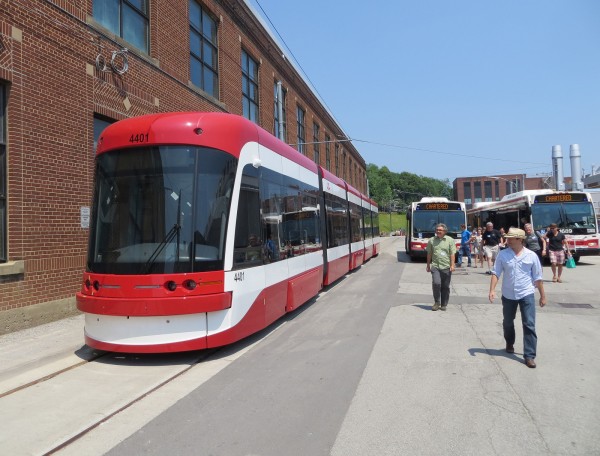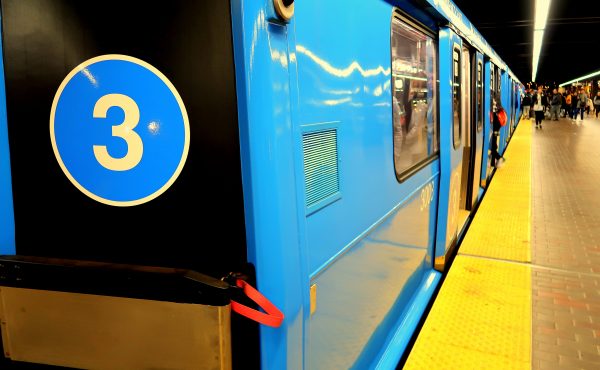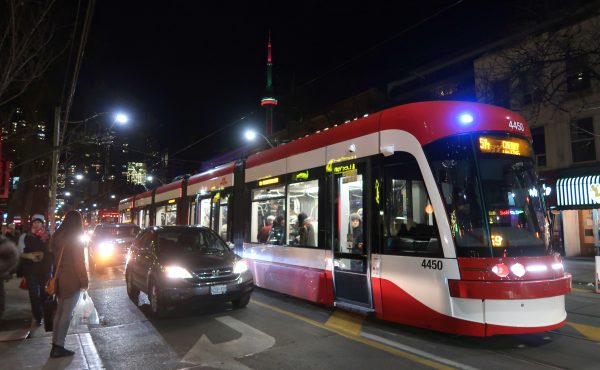
Riding the TTC’s new LRV on its maiden daylight voyage down Bathurst Street yesterday was a bit like taking a very showy sports car out for a spin. Heads turn, passersby point and stare, a few take pictures. Mid-morning commuters on the Bathurst streetcar platform seemed surprised, intrigued, and, yes, eager to board.
Torontonians, alas, will have to wait for another year before the $6 million specially-made Bombardier vehicles roll out into active service on the existing streetcar network. But a smartly-timed mini-junket for journalists on Tuesday offered the city’s digitally-stained wretches a chance to see these hotly debated vehicles up close and in motion.
A few factoids: the entire order of 204 vehicles cost $1.2 billion, and will gradually replace the existing fleet of almost 250 streetcars. Each has seating for 70 riders, and total standing capacity for 181 more — compared to 46 and 86 in the current models. These 30-metre-long vehicles can travel up to 80 km/hr, have specially equipped accessibility entrances with automatic ramps and external open buttons; interior racks for bikes and luggage, fold-down seats, face-to-face seating pairs, CCTVs and full air-conditioning. They will be equipped to take Presto swipe cards, but they’ll also have two on-board vending machines capable of taking tokens, tickets, cash and plastics. Riders can get on any entrance.
According to TTC officials, the first ones will go into service sometime next year — just in time for the election! — on the Spadina line, and they have been designed so they can navigate the tight turn radius in the Queen’s Quay tunnel to Union Station.
Between now and then, the TTC will continue building the Leslie Street LRV storage facility ($500 million), changing the overhead wiring to accommodate these higher-power vehicles, and adjusting curb cuts and platforms across the network. The total infrastructure cost is about $800 million.
The phase-in will continue through to mid-2018 (another election), with Dundas, Bathurst and Harbourfront coming online in 2014; Queen and Lakeshore in 2015; King in 2016, St. Clair in 2017 and the remaining routes (Downtowner, Kingston Road and Carlton) in 2018.
According to the TTC, streetcars carry 280,000 passengers a day, and logged 13 million kilometres with more than 87 million riders in 2011 (none of whose votes are important, by the way).
While there’s been debate about whether fewer, larger vehicles running less frequently represents a service deterioration, TTC spokesperson Brad Ross points out that the network, including the new vehicles, will reach capacity within a decade, at which point the TTC and City Council will have to order more of them.
One can only hope that by that point (which will arrive years before the first subway rolls into Scarborough Town Centre), council’s political right will have shed its knee-jerk views on LRTs and LRVs and state-of-the-art surface transit.
(Hoping, but not optimistic.)





6 comments
The fact that there will be fewer of these on the road than what is current means this will be a fiasco. The wait times for these will be ridiculous. It doesn’t matter if they hold more, that means nothing if you missed one and have to wait even longer than you do now before the next one arrives. This should be fun late at night when there already is a half-hour wait between streetcars. “Taxi!”
RE: Pete… more vehicles = more stopping = more bunching… you do realize that though the existing streetcars are supposed to show up more frequently most of the time they don’t because they end up in groups of 2 or 4?
According to the streetcar implementation, see http://www.ttc.ca/About_the_TTC/Commission_reports_and_information/Commission_meetings/2013/June_24/Reports/New_Streetcar_Implem.pdf for the plan, the off-peak times will be close to how it is at present. During the rush-hour, they will be more spread out, hopefully to avoid bunching.
Currently, passengers also bunch at the front doors to enter, while the new cars will allow for entering at all four doors.
In addition, the TTC is thinking about increasing the current 204 Bombardier Outlook order by another 60 (total 264), depending upon ridership.
If it were a nice sunny day, I wouldn’t bother waiting for a streetcar (regardless of rolling stock or frequencies) at King and Parliament to get to King and University because walking is faster. For long distance rides from Long Branch to downtown, I’m sure getting a ride in these new, fancy rolling stock is worth the wait. I’m going to hold judgment on frequencies, but the way I see these new rolling stock that they’re designed for comfortable, long distance travel, not for the speciality of Toronto’s streetcar network – the emphasis that its a streetcar network, ideal for short inter-neighbourhood travel, supplementing pedestrian and bike traffic, etc.
These rolling stock look like they belong in right-of-way routes. Pair them two together=boom, a Scarborough RT replacement. How about having these snake about the Beach(es) area at 4pm on a hot summer day?
^ Wrong. The existing streetcars will still run. These larger ones will alleviate high volume routes that are so packed you have to wait for the next one anyway.
It would seem to make sense to roll these out first on lines with very frequent service. Going from a 2 minute gap to a 4 minute gap will help reduce bunching, while still providing frequent service. Spadina is a perfect choice, therefore, because you can often see 3 cars in either direction during rushhour. But King should have been next – it has the heaviest usage of any surface route in Toronto.